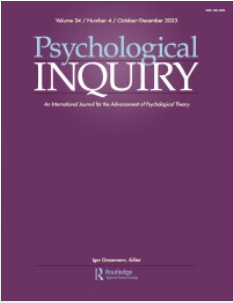超越意识:内隐偏见的多种形式及其启示
IF 4.1
2区 心理学
Q1 PSYCHOLOGY, MULTIDISCIPLINARY
引用次数: 1
摘要
1969年,乔治·米勒在向美国心理协会发表的演讲中恳求心理学界放弃其科学。就他们而言,公众已经表现出对那些可能有助于解决我们一些最棘手的社会问题的想法的渴望。隐性偏见是那些超越实验室的好想法之一,部分原因是隐性项目的积极努力(https://implicit.harvard.edu)。例如,希拉里·克林顿在2016年竞选失败期间宣称,“我们都有隐性偏见”(Merica,2016)。全世界都在关注我们的领域,以更好地了解隐性偏见是一种危险而普遍的病原体,还是一种稍微令人讨厌但大多是善意的好奇心。在象牙塔里,对于如何最好地定义这个结构没有明确的共识,这并没有起到任何作用(Cornelle&H€utter,2020)。在此背景下,Gawronski、Ledgerwood和Eastwick(本期;GLE)介绍了他们的目标文章。在他们文章的标题中,GLE向该领域的学者提出了一个简单的呼吁:无论刻板印象和态度的隐含衡量标准是什么,我们都不应该给这种隐含偏见(IB)贴上标签。我们完全同意这一结论,并很乐意在请愿书上签名,以避免这种用法继续下去(就像我们同样同意任何构造的度量和构造本身都不一样)。事实上,我们在最近的一份出版物中提出了类似的论点,“‘内隐联想’(通过IAT间接测量的头脑中概念之间的联想强度)和‘内隐偏见’(一个人与社会群体的内隐联想可能导致的不同待遇)这两个术语经常被同构地使用(参见De Houwer,2019)”(见Schmader、Dennehy和Baron的Pitfall#3,2022)。在那篇文章中,我们两人主张对什么是IB有更清晰的概念,并概述了偏见产生的不同途径,以便设计减轻偏见危害的工具的干预主义者有一个有效的行动手册。在这篇评论中,我们将分析重点放在GLE的一般定义上,即IB“抓住了人们可能在没有意识到自己的行为有偏见的情况下以有偏见的方式行事的想法”(Gawronski等人,本期,第139页)。我们同意GLE关注的是作为行为的偏见,而不是用内隐测量评估的个体差异。然而,我们建议,IB的这一特定定义必须进一步澄清意识在IB描述中的确切作用。我们认为,任何对偏见的明确概念化都需要认识到,脑海中的刻板印象和态度可能导致对他人造成伤害的偏见行为。根据最近发表的偏见类型学(Schmader et al.,2022),我们将看到,意识只是区分隐性偏见和显性(或故意)偏见所需的一个组成部分,即使在这些类别中,偏见也可以采取不同的形式,人们可以意识到过程的某些部分,但不能意识到其他部分。因此,与GLE声称IB的定义非常明确相反,我们认为还有一些模糊之处需要更多的关注。本文章由计算机程序翻译,如有差异,请以英文原文为准。
Beyond Awareness: The Many Forms of Implicit Bias and Its Implications
In 1969, in his address to the American Psychological Association, George Miller implored the field of psychology to give its science away. For their part, the general public has shown itself to have a thirst for those ideas that might be useful to solving some of our most intractable social problems. Implicit bias is one of those good ideas that has transcended the laboratory, in part because of the positive efforts of Project Implicit (https://implicit.harvard.edu). For example, during her failed election campaign in 2016, Hilary Clinton declared, “We all have implicit biases” (Merica, 2016). The world is looking to our field to better understand if implicit bias is a dangerous and prevalent pathogen or a mildly annoying but mostly benign curiosity. It hasn’t helped that within the ivory tower, there is no clear consensus on how to best define the construct (Corneille & H€ utter, 2020). Into this context, Gawronski, Ledgerwood, and Eastwick (this issue; GLE) introduce their target article. In the title of their article, GLE make a simple plea to scholars in the field: Whatever it is that implicit measures of stereotypes and attitudes capture, we should not label this implicit bias (IB). We completely agree with this conclusion and would like to happily sign our names to the petition to refrain from this usage moving forward (just as we would similarly agree that a measure of any construct and the construct itself are not one in the same). In fact, we made a similar argument in a recent publication stating, “too often the terms ‘implicit associations’ (the strength of the associations between concepts in the mind, measured indirectly by the IAT) and ‘implicit bias’ (disparate treatment that can result from one’s implicit associations with social groups) are used isomorphically (cf. De Houwer, 2019)” (see Pitfall #3 of Schmader, Dennehy, & Baron, 2022). In that article, two of us argued for having greater conceptual clarity over what IB is and outlined different pathways by which bias unfolds, so that interventionists designing tools to mitigate the harms from bias have an effective playbook to work from. In this commentary, we focus our analysis on GLE’s general definition that IB “captures the idea that people may behave in a biased way without being aware that their behavior is biased” (Gawronski et al., this issue, p. 139). We agree with GLE’s focus on bias as behavior, not on the individual differences assessed with implicit measures. We suggest, however, that this particular definition of IB must go further to clarify the precise role of awareness in the delineation of IB. We argue that any clear conceptualization of bias needs to recognize the process by which stereotypes and attitudes in mind can lead to biased behavior that does harm to others. Drawing from and extending a recently published bias typology (Schmader et al., 2022), we will see that awareness is only one component needed to distinguish implicit from explicit (or intentional) bias, and that even within these categories, bias can take different forms where people can be aware of some parts of the process but not of others. Thus, in contrast to GLE’s assertion that the definition of IB is quite clear, we believe there are remaining ambiguities that require greater focus.
求助全文
通过发布文献求助,成功后即可免费获取论文全文。
去求助
来源期刊

Psychological Inquiry
PSYCHOLOGY, MULTIDISCIPLINARY-
CiteScore
10.30
自引率
1.10%
发文量
31
期刊介绍:
Psychological Inquiry serves as an international journal dedicated to the advancement of psychological theory. Each edition features an extensive target article exploring a controversial or provocative topic, accompanied by peer commentaries and a response from the target author(s). Proposals for target articles must be submitted using the Target Article Proposal Form, and only approved proposals undergo peer review by at least three reviewers. Authors are invited to submit their full articles after the proposal has received approval from the Editor.
 求助内容:
求助内容: 应助结果提醒方式:
应助结果提醒方式:


